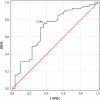Extracellular-to-body cell mass ratio and subjective global assessment in head-and-neck cancers
- PMID: 24523622
- PMCID: PMC3921049
- DOI: 10.3747/co.21.1671
Extracellular-to-body cell mass ratio and subjective global assessment in head-and-neck cancers
Abstract
Background: The ratio of extracellular mass to body cell mass (ecm/bcm), determined by bioelectrical impedance analysis, has been found to be a potentially useful indicator of nutrition status. Subjective global assessment (sga) is a subjective method of evaluating nutrition status in head-and-neck cancer. The present study was conducted to investigate the association between ecm/bcm and sga in head-and-neck cancer.
Methods: Patients were classified as either well-nourished or malnourished by sga. Bioelectrical impedance analysis was conducted on a population of 75 patients with histologically confirmed head-and-neck cancer, and the ecm/bcm was calculated. Receiver operating characteristic curves were estimated using the nonparametric method to determine an optimal cut-off value of the ecm/bcm.
Results: Compared with malnourished patients, those who were well-nourished had a statistically significantly lower ecm/bcm (1.11 vs. 1.28, p = 0.005). An ecm/bcm cut-off of 1.194 was 76% sensitive and 63% specific in detecting malnutrition.
Conclusions: The ecm/bcm can be an indicator that detects malnutrition in patients with head-and-neck cancer. Further observations are needed to validate the significance of the ecm/bcm and to monitor nutrition interventions.
Keywords: Head-and-neck cancer; bioelectrical impedance analysis; extracellular–to–body cell mass ratio; subjective global assessment.
Figures
Similar articles
-
Bioelectrical impedance phase angle and subjective global assessment in detecting malnutrition among newly diagnosed head and neck cancer patients.Eur Arch Otorhinolaryngol. 2016 May;273(5):1299-305. doi: 10.1007/s00405-015-3626-5. Epub 2015 Apr 10. Eur Arch Otorhinolaryngol. 2016. PMID: 25859939
-
The relationship between bioelectrical impedance phase angle and subjective global assessment in advanced colorectal cancer.Nutr J. 2008 Jun 30;7:19. doi: 10.1186/1475-2891-7-19. Nutr J. 2008. PMID: 18590554 Free PMC article.
-
Extracellular mass to body cell mass ratio as a potential index of wasting and fluid overload in hemodialysis patients. A case-control study.Clin Nutr. 2020 Apr;39(4):1117-1123. doi: 10.1016/j.clnu.2019.04.021. Epub 2019 Apr 24. Clin Nutr. 2020. PMID: 31060893
-
Body composition changes in patients with human immunodeficiency virus infection.Nutrition. 1997 Jul-Aug;13(7-8):629-32. doi: 10.1016/s0899-9007(97)83004-3. Nutrition. 1997. PMID: 9263254
-
[Nutritional status evaluation in maintenance hemodialysis patients].Rev Med Chir Soc Med Nat Iasi. 2008 Apr-Jun;112(2):343-50. Rev Med Chir Soc Med Nat Iasi. 2008. PMID: 19295002 Romanian.
Cited by
-
Safety and Feasibility of Fasting-Mimicking Diet and Effects on Nutritional Status and Circulating Metabolic and Inflammatory Factors in Cancer Patients Undergoing Active Treatment.Cancers (Basel). 2021 Aug 9;13(16):4013. doi: 10.3390/cancers13164013. Cancers (Basel). 2021. PMID: 34439167 Free PMC article.
-
Increased extracellular water/body mass is associated with functional impairment in hemodialysis patients.Ren Fail. 2023;45(2):2271066. doi: 10.1080/0886022X.2023.2271066. Epub 2023 Nov 21. Ren Fail. 2023. PMID: 38532722 Free PMC article.
-
Nutritional Deficiencies in Radiotherapy-Treated Head and Neck Cancer Patients.J Clin Med. 2021 Feb 3;10(4):574. doi: 10.3390/jcm10040574. J Clin Med. 2021. PMID: 33546506 Free PMC article. Review.
-
Bioelectrical impedance phase angle and subjective global assessment in detecting malnutrition among newly diagnosed head and neck cancer patients.Eur Arch Otorhinolaryngol. 2016 May;273(5):1299-305. doi: 10.1007/s00405-015-3626-5. Epub 2015 Apr 10. Eur Arch Otorhinolaryngol. 2016. PMID: 25859939
-
The value of bioelectrical impedance analysis and phase angle in the evaluation of malnutrition and quality of life in cancer patients--a comprehensive review.Eur J Clin Nutr. 2015 Dec;69(12):1290-7. doi: 10.1038/ejcn.2015.126. Epub 2015 Jul 29. Eur J Clin Nutr. 2015. PMID: 26220573 Review.
References
-
- Naber TH, Schermer T, de Bree A, et al. Prevalence of malnutrition in nonsurgical hospitalized patients and its association with disease complications. Am J Clin Nutr. 1997;66:1232–9. - PubMed
LinkOut - more resources
Full Text Sources
Other Literature Sources
Research Materials


